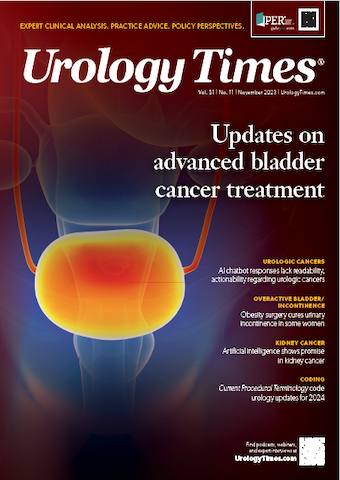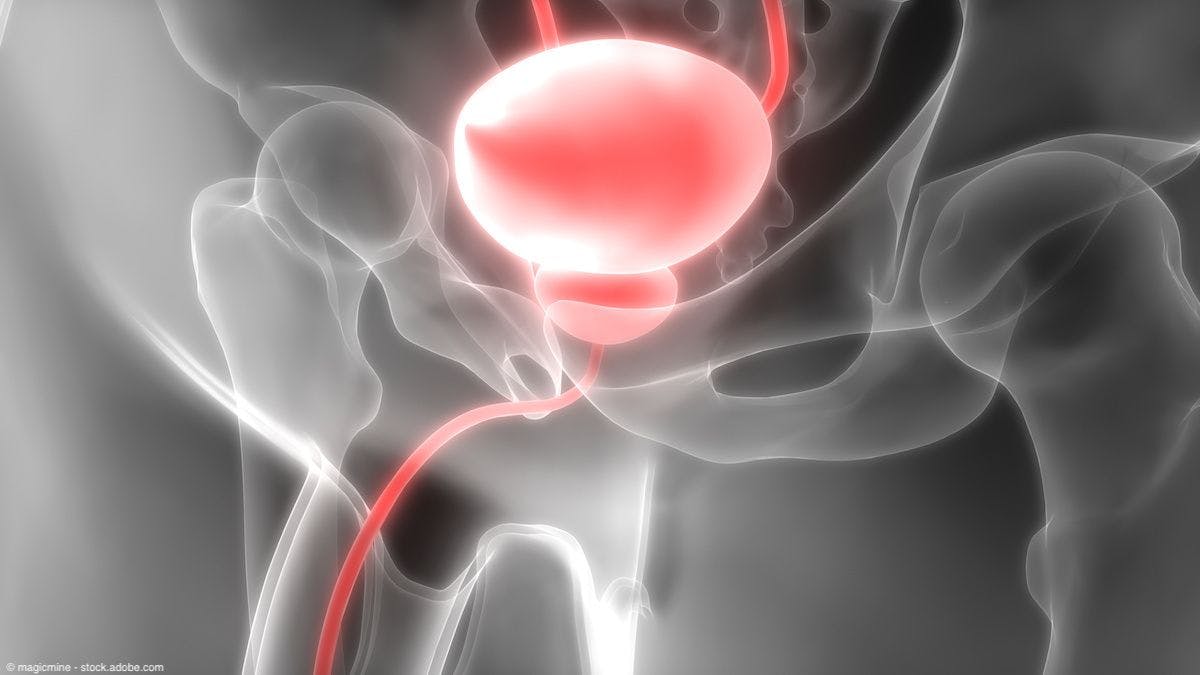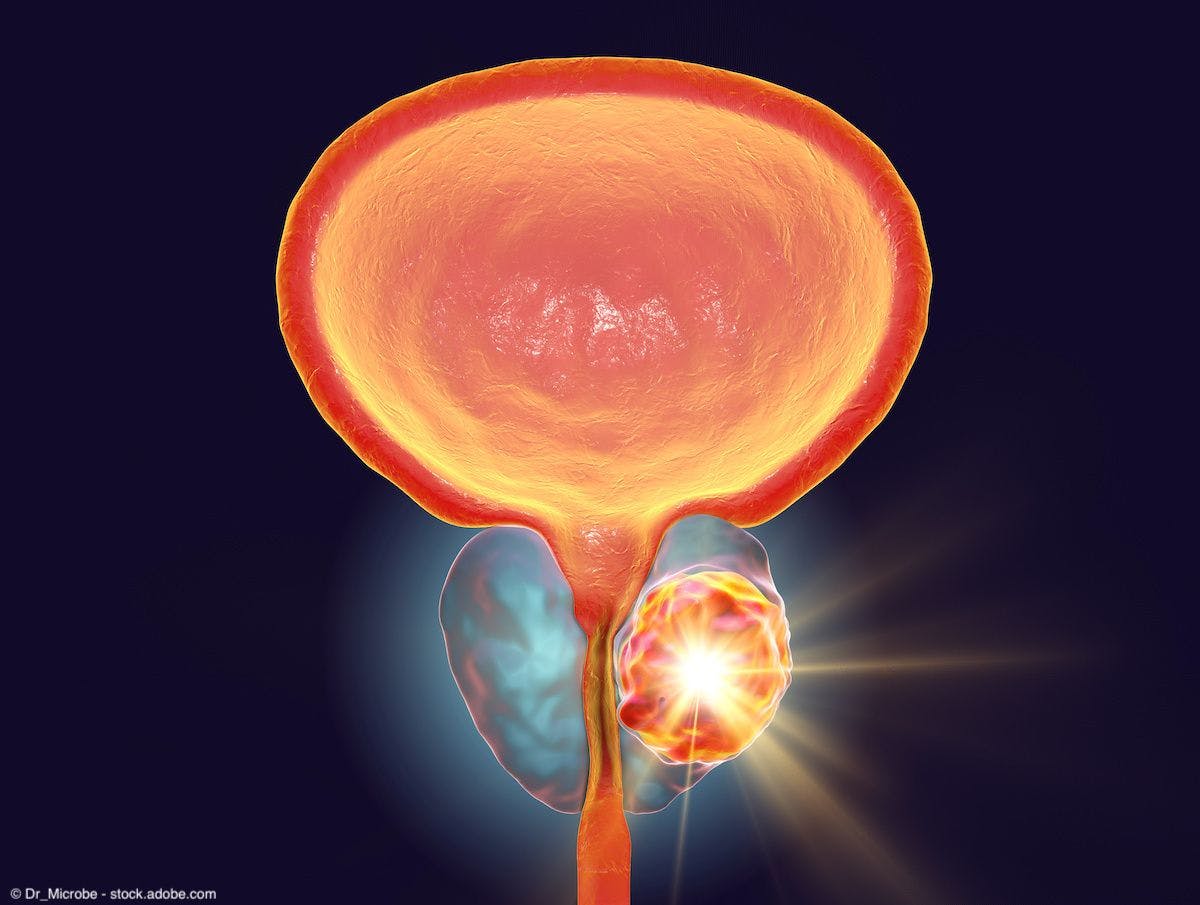Feature
Article
Urology Times Journal
Updates on advanced bladder cancer treatment
Author(s):
"If a patient begins treatment with platinum-based chemotherapy and maintenance immune checkpoint inhibition, second-line options may involve evaluating erdafitinib, ADCs, or participation in clinical trials," says Adanma Ayanambakkam, MD.
Adanma Ayanambakkam, MD

In this interview, Adanma Ayanambakkam, MD, discusses the current state of treatment of advanced bladder cancer, including treatment sequencing and the concept of pseudoprogression and its role in treatment. Ayanambakkam is an assistant professor of medicine in the section of hematology/oncology at the University of Oklahoma in Oklahoma City.
What are the current first-line treatment options for advanced bladder cancer in cisplatin-eligible patients?
Ayanambakkam: In the context of metastatic urothelial cancer, the most critical decision-making point hinges on the patient’s eligibility for cisplatin. Several factors must be taken into consideration, including comorbidities such as hearing loss, preexisting neuropathy, cardiac function, and the patient’s overall performance status, to determine their eligibility for cisplatin. Established criteria, such as the Galsky criteria, play a defining role in assessing eligibility for cisplatin-based chemotherapy. These criteria specify cisplatin eligibility as having a creatinine clearance greater than 60 mL/min, peripheral neuropathy less than or equal to grade 2, or not exceeding [New York Heart Association] Class III heart failure.
For patients considered cisplatin eligible, which chemotherapy options are appropriate?
Ayanambakkam: Currently, there are 2 approved frontline treatment options for metastatic urothelial cancer: gemcitabine with cisplatin or dose-dense MVAC [methotrexate, vinblastine, doxorubicin, and cisplatin]. Comparative studies between gemcitabine-cisplatin and standard-dose MVAC have shown that although gemcitabine-cisplatin is not superior, it is considerably more tolerable. Dose-dense MVAC, on the other hand, is known to offer better overall survival and objective response outcomes. Trials examining dose-dense MVAC have reported a 24% survival rate at the end of 7 years, indicating its significant effectiveness. Therefore, for cisplatin-eligible patients, dose-dense MVAC is generally preferred, particularly for those who are younger and maintain a good performance status. Nevertheless, gemcitabine plus cisplatin remains an acceptable alternative, especially for older patients, due to its comparably better tolerance.
Subsequently, the introduction of maintenance avelumab [Bavencio] in the [phase 3] JAVELIN Bladder 100 trial [NCT02603432] has added a new dimension to treatment.1 This trial assesses the role of maintenance immune checkpoint inhibition followed by platinum-based chemotherapy. Maintenance avelumab has proven its effectiveness, with a median overall survival of nearly 2 years when compared with best supportive care alone. Therefore, the current standard of care for platinum-eligible patients involves 4 to 6 cycles of platinum-based chemotherapy, a decision influenced by the treating physician and the patient’s preferences. However, this landscape is poised for change soon, as recently released [phase 3] EV-302 data2 [NCT04223856] indicate substantial survival benefits for patients receiving frontline pembrolizumab [Keytruda] plus enfortumab vedotin-ejfv [Padcev], with expectations of gaining FDA fast track approval in the coming months.
Please discuss treatment options in patients who are cisplatin ineligible.
Ayanambakkam: Unfortunately, a significant portion of our patients are ineligible for cisplatin therapy due to either comorbidities or underlying renal dysfunction. Additionally, there are instances where patients who are initially candidates for cisplatin treatment end up not receiving it due to the distinct [adverse] effect profile associated with cisplatin. Consequently, for patients who are not eligible right from the start or for those who become ineligible due to [adverse] effects after a few cycles of cisplatin, we make a transition to carboplatin.
However, it’s important to note that carboplatin is considered a less effective alternative when compared with cisplatin. We do not recommend initiating treatment with carboplatin for all metastatic patients. In contrast to scenarios like metastatic lung cancer where carboplatin is the preferred choice and cisplatin is not used, the context differs in urothelial cancer. Here, cisplatin-based chemotherapy is still the recommended approach for all patients. However, if an individual is unable to tolerate cisplatin or is ineligible for it, then carboplatin becomes a reasonable alternative. Among the cisplatin alternatives, we commonly employ carboplatin-gemcitabine as the primary regimen.
In light of the JAVELIN Bladder 100 trial, which investigated the role of maintenance avelumab, the findings demonstrated that irrespective of whether patients received cisplatin or carboplatin, they still experienced benefits from maintenance avelumab. Therefore, the same decision-making process concerning platinum eligibility is followed, with the subsequent use of carboplatin followed by maintenance immunotherapy for patients with metastatic urothelial carcinoma.
Continuing with first line, what are the treatment options for patients with good performance status who are platinum ineligible?
Ayanambakkam: In the case of patients who are ineligible for platinum-based treatments, there has been extensive research exploring the effectiveness of immune checkpoint inhibitors such as pembrolizumab as viable alternatives. Notably, the KEYNOTE-052 trial [NCT02335424], a phase 2 study, investigated pembrolizumab in patients who couldn’t receive cisplatin. The results revealed an objective response rate of
24%, with 5% achieving complete responses.3 Looking at longer-term outcomes, the median overall survival approached 11 months, coupled with an objective response rate of 28.6%.4 This study generated considerable enthusiasm, leading to the adoption of pembrolizumab for cisplatin-ineligible patients instead of using carboplatin-based alternatives. It was observed that patients with higher PD-L1 expression, specifically a combined proportion score exceeding 10, were more likely to respond to PD-L1 inhibitors.
However, in 2018, after examining data from KEYNOTE-361 [NCT02853305] and IMvigor130 [NCT02807636], [both phase 3 trials,] the FDA issued a safety alert regarding the use of frontline immune checkpoint inhibitors like pembrolizumab and atezolizumab [Tecentriq]. The studies identified a decrease in overall survival for patients who received frontline immune checkpoint inhibition rather than a platinum-based approach. In other words, patients tended to fare better when they received up-front platinum-based chemotherapy, whether cisplatin or carboplatin, rather than immune checkpoint inhibitors. Therefore, it is highly recommended to assess a patient’s eligibility for platinum-based treatments. If they are eligible, cisplatin is the preferred choice, and if not, then carboplatin. If platinum-based chemotherapy is not an option due to ineligibility or patient preference, pembrolizumab is a reasonable alternative.
For patients who are ineligible for cisplatin and exhibit very high PD-L1 expression [defined as a combined proportion score over 10], pembrolizumab might be a suitable alternative. However, platinum-based treatments continue to hold significance in the frontline management of metastatic urothelial cancer.
Despite the emphasis on platinum-based treatments, there have been multiple trials exploring the combination of chemotherapy and immune checkpoint inhibition in an attempt to enhance treatment efficacy. However, the results have not been particularly groundbreaking. This changed with the introduction of the recent EV-103 trial [NCT03288545]. Published in the Journal of Clinical Oncology,5 this [phase 1/2] trial evaluates a combination of pembrolizumab immune checkpoint inhibition and an antibody-drug conjugate [ADC] called enfortumab vedotin-ejfvin cisplatin-ineligible patients as a first-line treatment. Importantly, this regimen does not include traditional chemotherapy; instead, it involves enfortumab vedotin-ejfv, an ADC featuring a Nectin-4-directed antibody with a microtubule inhibitor conjugate. The EV-103 combination of pembrolizumab and enfortumab vedotin-ejfv demonstrated a remarkable median overall survival of approximately 26 months, along with a median progression-free survival of about 12.3 months. Achieving a median duration of response and overall survival exceeding 2 years in patients who have not undergone platinum-based chemotherapy is a noteworthy development. Consequently, more patients are now receiving this combination up front, and it has received FDA fast track approval, with ongoing evaluation in phase 3 trials.
The recent platinum shortage across the United States has also underlined the importance of this effective combination approach. Furthermore, results from the [phase 3] EV-302/KEYNOTE-A39 trial [NCT04223856], presented at the 2023 European Society for Medical Oncology Annual Congress in Madrid, Spain, revealed that compared with platinum-based chemotherapy [cisplatin or carboplatin], pembrolizumab plus enfortumab vedotin-ejfv nearly doubled median progression-free survival [12.5 months vs 6.3 months, respectively; HR, 0.45; 95% CI, 0.38-0.54; P < .00001] and median overall survival [31.5 months vs 16.1 months, respectively; HR, 0.47; 95% CI, 0.38-0.58; P < .00001].2
Please talk about second-line approaches and related clinical trials.
Ayanambakkam: A pivotal trial in the realm of second-line treatments was the [phase 3] KEYNOTE-045 trial [NCT02256436], which compared pembrolizumab with second-line chemotherapy.6 It’s important to note that this trial occurred before the widespread use of immune checkpoint inhibition as a frontline therapy. These patients were not those who had experienced disease progression in the JAVELIN Bladder 100 trial or those who had received the pembrolizumab–enfortumab vedotin-ejfv combination. Instead, they were individuals who had initially undergone platinum-based chemotherapy as a first-line treatment and were now under evaluation in the second-line setting.
KEYNOTE-045 revealed that using pembrolizumab as a second-line treatment resulted in a longer median overall survival of 10 months compared with 7 months, reflecting a notable 3-month difference in overall survival. Furthermore, the incidence of treatment-related adverse events was significantly lower when compared with traditional chemotherapy. Not only was pembrolizumab better tolerated in the second-line setting, but it also demonstrated increased efficacy with improved overall survival and extended median duration of response. As a result, this trial prompted the [National Comprehensive Cancer Network] to assign a category 1 recommendation for pembrolizumab in second-line metastatic urothelial carcinoma. It’s crucial to bear in mind that atezolizumab now holds a category 2B recommendation and is primarily intended for tumors displaying PD-L1 positivity.
In situations where a patient has received platinum-based chemotherapy as their initial treatment and has not undergone prior immune checkpoint inhibition, pembrolizumab is the recommended course of action. However, this scenario is evolving due to the increasing use of up-front maintenance avelumab, up-front pembrolizumab in cisplatin-ineligible and high–PD-L1 patients, and the FDA recently approved pembrolizumab plus enfortumab vedotin-ejfv.Consequently, the use of pembrolizumab in the second-line setting is becoming less common, as most patients are now receiving it as their first-line treatment.
What has become more significant in recent times in the second-line setting are ADCs, of which there are 2. One of them is enfortumab vedotin-ejfv, as previously discussed, evaluated in the [phase 3] EV-301 trial [NCT03474107] for patients who had experienced progression after platinum therapy and subsequent immune checkpoint inhibition.7 The results showcased a remarkable objective response rate of approximately 40%, including a complete response rate of around 5%. This trial emphasized the potency of enfortumab vedotin-ejfv, even in the third-line setting, with a median overall survival of approximately 12.88 months and a median progression-free survival of approximately 5.5 months.
The second ADC in this category is sacituzumab govitecan-hziy [Trodelvy], a Trop-2-directed antibody combined with a topoisomerase inhibitor. It was evaluated in the TROPHY-U-01 trial [NCT03547973], specifically in a phase 2 cohort comprising patients who had progressed after previous platinum and immune checkpoint inhibition. This assessment revealed a notable objective response rate of 27%, with a median progression-free survival of 5.5 months and a median overall survival of 10.9 months.8
Given the rapidly evolving treatment landscape for metastatic urothelial carcinoma, it is essential to consider the context in which pembrolizumab plus enfortumab vedotin-ejfv is used as a frontline therapy. If patients are already receiving pembrolizumab and enfortumab vedotin-ejfv in the first-line setting, the standard approach for the second-line treatment becomes platinum-based chemotherapy. In the event of progression during this second-line chemotherapy, sacituzumab govitecan-hziy is an option for sequential use.
Additionally, it’s worth noting erdafitinib [Balversa], which is FDA approved for patients with FGFR3 and FGFR2 genetic alterations. Guidelines recommend screening for FGFR mutations, especially FGFR3 and FGFR2 genetic alterations. Erdafitinib is effective even in platinum-resistant metastatic urothelial carcinoma, with an objective response rate of approximately 40% and 3% complete responses. The median progression-free survival is around 5.5 months, and the median overall survival is about 13.8 months.9
In summary, if a patient begins treatment with platinum-based chemotherapy and maintenance immune checkpoint inhibition, second-line options may involve evaluating erdafitinib, ADCs, or participation in clinical trials. In cases where pembrolizumab and ADCs are the initial approach, second-line choices could include clinical trials or platinum-based chemotherapy, with sacituzumab govitecan-hziy or erdafitinib being considered for use in the third- or fourth-line settings for appropriate individuals. Always bear in mind the guideline recommendations for considering clinical trial enrollment in the second- and third-line settings and explore available options in academic and other institutions to maximize the benefits of agents under investigation in this field.
Could you explain the concept of pseudoprogression and its implications for patients receiving immune checkpoint inhibition?
Ayanambakkam: The landscape of cancer treatment has been greatly transformed by the introduction of immune checkpoint inhibition, leading to substantial improvements in the outcomes of patients with metastatic urothelial cancer. However, it is crucial to be aware of unique responses that can occur with immune checkpoint inhibition, one of which is known as pseudoprogression.
Pseudoprogression is characterized by a temporary increase in tumor size or the emergence of new tumor lesions in response to immune checkpoint inhibition. In simple terms, it occurs when radiographic imaging reveals a growth in tumor size or the appearance of new lesions while patients are undergoing treatment with an immune checkpoint inhibitor. Initially, such changes were often misinterpreted as rapid disease progression, leading to the discontinuation of immune checkpoint inhibition, followed by a shift to alternative treatment options. However, subsequent discoveries have shown that some individuals experience a spontaneous resolution of this temporary increase, indicating pseudoprogression. This temporary enlargement is believed to be linked to alterations in the immune microenvironment, potentially involving an influx of immune cells due to the effects of immune checkpoint inhibition.
It is now imperative to exercise caution when considering early discontinuation of therapy based solely on the initial signs of disease progression on a scan. Always keep pseudoprogression in mind. However, it’s essential to strike a balance, as assuming pseudoprogression and continuing immune checkpoint treatment when genuine disease progression is occurring can be problematic. Typically, immune checkpoint-mediated pseudoprogression is observed in patients who are feeling well. These patients may show radiographic evidence of worsening disease burden but exhibit fewer cancer-related symptoms. In such cases, suspicion of pseudoprogression is higher. On the other hand, patients who experience significant clinical deterioration are less likely to be experiencing pseudoprogression, and careful consideration of alternative treatment options is warranted.
As of now, there are no specific imaging criteria or approved biomarkers to definitively identify immune checkpoint–mediated pseudoprogression. Nonetheless, it is a critical consideration when evaluating scans of patients undergoing immune checkpoint inhibition, particularly when radiographic progression is noted. This phenomenon can manifest as early as a few weeks into treatment or even several months after initiating treatment.
To enhance the accurate characterization and definition of pseudoprogression in patients participating in clinical trials, the RECIST [Response Evaluation Criteria in Solid Tumors] 1.1 imaging criteria have been updated and rebranded as iRECIST, with the prefix “i” signifying “immune.” This modification has introduced novel approaches to describing responses, specifically immune complete response, immune partial response, and immune stable disease. Additionally,
2 new terms have been introduced: iUPD [immune unconfirmed progressive disease] and iCPD [immune confirmed progressive disease].
Under the iRECIST framework, progression is categorized as iUPD, and a subsequent scan is performed 4 to 6 weeks later. If the subsequent scans reveal a positive response, this is considered pseudoprogression. Conversely, radiographic progression observed on subsequent scans is labeled as iCPD. This approach involves a challenging balance wherein patients are administered treatment for 4 to 6 weeks with the assumption that it is effective while hoping that true disease progression is not the case. In some cases, this means that a subset of individuals may be subjected to treatment that lacks efficacy, resulting in a delay in the initiation of a more beneficial treatment that could have otherwise improved clinical outcomes. It is equally essential to acknowledge that this exposes patients to the potential [adverse] effects of an ineffective treatment. Considerable ongoing research efforts are focused on gaining a deeper understanding of this concept and identifying biomarkers that hold clinical significance in this context.
References
1. Powles T, Park SH, Voog E, et al. Avelumab maintenance therapy for advanced or metastatic urothelial carcinoma. N Engl J Med. 2020; 383:1218-1230. doi:10.1056/NEJMoa2002788
2. Powles TB, Perez Valderrama B, Gupta S, et al. EV-302/KEYNOTE-A39: Open-label, randomized phase III study of enfortumab vedotin in combination with pembrolizumab (EV+P) vs chemotherapy (Chemo) in previously untreated locally advanced metastatic urothelial carcinoma (la/mUC). Presented at: European Society for Medical Oncology Congress 2023; October 20-24, 2023; Madrid, Spain. Abstract LBA6
3. Balar AV, Castellano D, O’Donnell PH, et al. First-line pembrolizumab in cisplatin-ineligible patients with locally advanced and unresectable or metastatic urothelial cancer (KEYNOTE-052): a multicentre, single-arm, phase 2 study. Lancet Oncol. 2017;18(11):1483-1492. doi:10.1016/S1470-2045(17)30616-2
4. Vuky J, Balar AV, Castellano D, et al. Long-term outcomes in KEYNOTE-052: phase II study investigating first-line pembrolizumab in cisplatin-ineligible patients with locally advanced or metastatic urothelial cancer. J Clin Oncol. 2020;38(23):2658-2666. doi: 10.1200/JCO.19.01213
5. Hoimes CJ, Flaig TW, Milowsky MI, et al. Enfortumab vedotin plus pembrolizumab in previously untreated advanced urothelial cancer. J Clin Oncol. 2023;41(1):22-31. doi:10.1200/JCO.22.01643
6. Fradet Y, Bellmunt J, Vaughn DJ, et al. Randomized phase III KEYNOTE-045 trial of pembrolizumab versus paclitaxel, docetaxel, or vinflunine in recurrent advanced urothelial cancer: results of >2 years of follow-up. Ann Oncol. 2019;30(6):970-976. doi: 10.1093/annonc/mdz127
7. Rosenberg JE, O’Donnell PH, Balar AV, et al. Pivotal trial of enfortumab vedotin in urothelial carcinoma after platinum and anti-programmed death 1/programmed death ligand 1 therapy. 2019;37(29):2592–2600. doi:10.1200/JCO.19.01140
8. Tagawa ST, Balar AV, Petrylak DP, et al. TROPHY-U-01: a phase II open-label study of sacituzumab govitecan in patients with metastatic urothelial carcinoma progressing after platinum-based chemotherapy and checkpoint inhibitors. J Clin Oncol. 2021;39(22):2474–2485.doi:10.1200/JCO.20.03489
9. Loriot Y, Necchi A, Park SH, et al. Erdafitinib in locally advanced or metastatic urothelial carcinoma. N Engl J Med. 2019;381:338-348. doi:10.1056/NEJMoa1817323

Newsletter
Stay current with the latest urology news and practice-changing insights — sign up now for the essential updates every urologist needs.
























